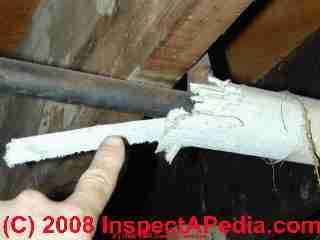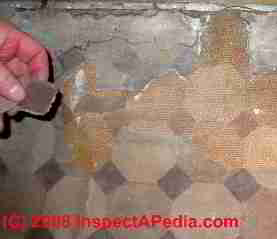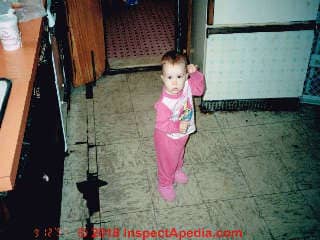 Photo Guide to Visual Asbestos Risk Assessment in buildings
Photo Guide to Visual Asbestos Risk Assessment in buildings
- POST a QUESTION or COMMENT about making a visual determination of the level of risk based on the condition or nature of asbestos-containing materials in buildings
Visual guide to asbestos risk assessment in buildings:
How to conduct a visual inspection for asbestos risks in buildings: Essential questions to ask in assessing the asbestos hazard risk.
This article discusses basic asbestos risk factors in buildings, simple visual inspection procedures, and summarizes current best judgment on removing versus leaving asbestos alone indoors. Visual inspection for asbestos is not a substitute for forensic investigation, air and dust sampling to detect asbestos contamination in buildings due to disturbance of that material.
This is part of our document which assists building buyers, owners or inspectors who need to identify asbestos materials (or probable-asbestos) in buildings by simple visual inspection.
InspectAPedia tolerates no conflicts of interest. We have no relationship with advertisers, products, or services discussed at this website.
- Daniel Friedman, Publisher/Editor/Author - See WHO ARE WE?
Asbestos Risk Factors
 Asbestos, a mineral fiber mined from the earth and used as a fire proof insulating material as well as in other products,
has been a major occupational and safety hazard of great concern since the 1930's.
Asbestos, a mineral fiber mined from the earth and used as a fire proof insulating material as well as in other products,
has been a major occupational and safety hazard of great concern since the 1930's.
Out of the work place, in homes and offices, there are also potential health hazards, in particular if asbestos material is damaged, disturbed, in poor condition, or located where it is likely to suffer these effects.
But often asbestos-containing material can and should simply be left alone, undisturbed. Unnecessary disturbance of asbestos materials in such buildings is at risk of creating a more severe hazard than leaving it alone. In other cases asbestos encapsulation may be recommended.
The decision to leave asbestos alone, encapsulate it, or removing asbestos depends largely on the type of material, its location, its condition, and its exposure to mechanical damage or fiber release.
Comments at each example shown in this document indicate the reasons that further asbestos testing or removal are likely to be needed or likely to be unnecessary.
Human exposure to airborne asbestos fibers has been linked to asbestosis and is a health hazard.
Here is a series of photographs of places I've found common asbestos materials in buildings, and also where I've found recognizable asbestos in a few surprise locations.
 We also look at asbestos fibers in our forensic microscopy lab, but
we're addressing on-site visual inspection for asbestos here, not polarized-light microscopy such as our lab photo of crocidolite.
We also look at asbestos fibers in our forensic microscopy lab, but
we're addressing on-site visual inspection for asbestos here, not polarized-light microscopy such as our lab photo of crocidolite.
Curved asbestos fibers chrysotile. Straight asbestos fibers are amphiboles. The five amphiboles include amosite, anthophyllite, tremolite, actinolite, crocidolite. Chrysotile is the most commonly-found asbestos fiber.
The carcinogenicity of asbestos varies according to fiber length and diameter. The most dangerous fibers were those longer than 8microns and less than 1.5 microns in diameter.
Asbestos fibers shorter than 3-5 microns in length were reported to have a very low, if any, carcinogenicity.
(According to McCrone who in turn quoted studies by King, Klosterkotter, Hilscher, Davis Stanton, Pott, eta als.)
The Essential Asbestos Questions to Ask in Assessing the Asbestos Hazard Risk in a Building
 Walter McCrone posed the following 5 key things that a building owner should know in deciding what to do about possible
asbestos in his or her building:
Walter McCrone posed the following 5 key things that a building owner should know in deciding what to do about possible
asbestos in his or her building:
- Are fibers present?
- Are they asbestos?
- If there are asbestos fibers present, in what proportion of the total?
- What other substances are present
(cellulose fibers, mineral wool, fiberglass, vermiculite, talc, perlite, pumice, diatomaceous earth, organic fibers, clays, glass powder, quartz, calcite, gypsum (drywall dust), plaster dust, etc.) [some additions by DJF] - What is Friability (how easily are particles released into the air), effectiveness of existing isolation or encapsulation.
[McCrone refers to asbestos materials which are friable - and so are more likely to be present in air, dust, or the environment.
Adbestos-containing floor tiles do not release high levels of asbestos fibers unless they are subjected to abrasion.
But the kitchen floor shown in this photo is in poor condition and could be a source of airborne asbestos as they continue to break up under foot traffic, even under disturbance by the feet of a toddler.
See ASBESTOS FLOORING HAZARD LEVEL ASSESSMENT for details.
McCrone's five questions are focused on the examination of a particle sample, probably an air sample of an indoor environment being tested for asbestos. Field experience suggests adding a 6th and a 7th question:
- Is there obvious, visibly recognizable asbestos or asbestos-suspect material in
the building?
(Some building materials are unmistakably asbestos or asbestos-containing and can be identified without lab analysis. They are shown in photographs provided below.) - Is the asbestos friable? Perhaps re-stating #5 above in a compound question on friability: what is the general condition of the asbestos material?
Is it damaged and thus more likely to be friable? Is it in a location which is likely to move asbestos particles into an occupied space by air movement or by human movement?
In effect, these questions assist in evaluating the potential asbestos hazard in a building. Simply looking at a snapshot of airborne asbestos particles is very unreliable.
Our work examining airborne particles in a large number of buildings indicates that very significant variations in the level of airborne particles (of all kinds) occur as a result of variations in normal building activity such as whether or not people are even in the building, fans being turned on or off, windows open or shut, vacuuming of surfaces during "cleaning", etc.
So a "low" number in any airborne particle measurement is not, alone, reliable in characterizing building risk. [DF]
Reader Question: extent hazard from asbestos containing floor tiles that are damaged by flooding
(Oct 26, 2014) Jack S said:
Our basement has what appears to be Armstrong Palimino Beige tiles - the mix of beige, brown and green colors. The basement has flooded on numerous occasions and some of the tiles have pulled loose or buckled slightly.
How concerned should we be about the condition of this floor posing health risks?
Reply:
Flooding that produces loose floor tiles mean that they can become broken up - a possible source of airborne asbestos dust in the building. Without knowing the actual condition of your floor it's hard to be more specific about the actual risk level without a competent onsite inspection.
Meanwhile don't create a risk by making a dusty mess nor should you use a household vacuum cleaner in the area as those actions may increase the level of airborne dust and debris.
You will want to take a look at the asbestos floor hazard reduction articles we list below.
...
Continue reading at ASBESTOS in GOOD CONDITION or select a topic from the closely-related articles below, or see the complete ARTICLE INDEX.
Or see these
Recommended Articles
- ASBESTOS DUCTS, HVAC a field identification guide to visual detection of asbestos in and on heating and cooling system ducts and flue vents.
- ASBESTOS FLOORING HAZARD REDUCTION
- ASBESTOS FLOORING REMOVAL GUIDE
- ASBESTOS in GOOD CONDITION
- ASBESTOS in POOR CONDITION
Suggested citation for this web page
ASBESTOS RISK ASSESSMENT at InspectApedia.com - online encyclopedia of building & environmental inspection, testing, diagnosis, repair, & problem prevention advice.
Or see this
INDEX to RELATED ARTICLES: ARTICLE INDEX to ASBESTOS HAZARDS
Or use the SEARCH BOX found below to Ask a Question or Search InspectApedia
Ask a Question or Search InspectApedia
Try the search box just below, or if you prefer, post a question or comment in the Comments box below and we will respond promptly.
Search the InspectApedia website
Note: appearance of your Comment below may be delayed: if your comment contains an image, photograph, web link, or text that looks to the software as if it might be a web link, your posting will appear after it has been approved by a moderator. Apologies for the delay.
Only one image can be added per comment but you can post as many comments, and therefore images, as you like.
You will not receive a notification when a response to your question has been posted.
Please bookmark this page to make it easy for you to check back for our response.
IF above you see "Comment Form is loading comments..." then COMMENT BOX - countable.ca / bawkbox.com IS NOT WORKING.
In any case you are welcome to send an email directly to us at InspectApedia.com at editor@inspectApedia.com
We'll reply to you directly. Please help us help you by noting, in your email, the URL of the InspectApedia page where you wanted to comment.
Citations & References
In addition to any citations in the article above, a full list is available on request.
- 3/07: thanks to Gary Randolph, Ounce of Prevention Home Inspection, LLC Buffalo, NY, for attentive reading and editing suggestions. Mr. Randolph can be reached in Buffalo, NY, at (716) 636-3865 or email: gary@ouncehome.com
- 06/07: thanks for photographs of transite asbestos heating ducts, courtesy of Thomas Hauswirth, Managing Member of Beacon Fine Home Inspections, LLC and (in 2007) Vice President, Connecticut Association of Home Inspectors Ph. 860-526-3355 Fax 860-526-2942 beaconinspections@sbcglobal.net
- June 1997 - Window Putty - OSHA case cites contractor for asbestos exposure during removal of window putty http://www.osha.gov/pls/oshaweb/owadisp.show_document?p_table=NEWS_RELEASES&p_id=1091
- Asbestos Identification, Walter C.McCrone, McCrone Research Institute, Chicago, IL.1987 ISBN 0-904962-11-3. Dr. McCrone literally "wrote the book" on asbestos identification procedures which formed the basis for current work by asbestos identification laboratories.
- Stanton, .F., et al., National Bureau of Standards Special Publication 506: 143-151
- Pott, F., Staub-Reinhalf Luft 38, 486-490 (1978) cited by McCrone
- "Handling Asbestos-Containing roofing material - an update", Carl Good, NRCA Associate Executive Director, Professional Roofing, February 1992, p. 38-43
- EPA Guidance for Controlling Asbestos-Containing Materials in buildings, NIAST, National Institute on Abatement Sciences & Technology, [republishing EPA public documents] 1985 ed., Exposure Evaluation Division, Office of Toxic Substances, Office of Pesticides and Toxic Substances, U.S. Environmental Protection Agency, Washington,D.C. 20460
- In addition to citations & references found in this article, see the research citations given at the end of the related articles found at our suggested
CONTINUE READING or RECOMMENDED ARTICLES.
- Carson, Dunlop & Associates Ltd., 120 Carlton Street Suite 407, Toronto ON M5A 4K2. Tel: (416) 964-9415 1-800-268-7070 Email: info@carsondunlop.com. Alan Carson is a past president of ASHI, the American Society of Home Inspectors.
Thanks to Alan Carson and Bob Dunlop, for permission for InspectAPedia to use text excerpts from The HOME REFERENCE BOOK - the Encyclopedia of Homes and to use illustrations from The ILLUSTRATED HOME .
Carson Dunlop Associates provides extensive home inspection education and report writing material. In gratitude we provide links to tsome Carson Dunlop Associates products and services.

